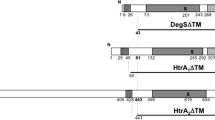Abstract
The Gram-positive bacterium Lactococcus lactis is an ideal expression host for the overproduction of heterologous proteins in a functional form. L. lactis has recently been identified as an efficient Gram-positive cell factory for the production of recombinant proteins and the safety of this production system has been confirmed in multiple clinical trials. Key desirable features of L. lactis include its generally recognized as safe (GRAS) status, long history of safe use in food production, probiotic properties, absence of endotoxins, capacity to secrete stable recombinant protein to the growth medium, the presence of few proteases, and a diverse selection of cloning and inducible expression vectors. Growth of lactococci is rapid, proceeds to high cell densities, and does not require aeration, which facilitates large-scale fermentation. We have previously described the production of several Plasmodium falciparum antigens with varying degrees of predicted structural complexities, those which are considered difficult-to-produce proteins by using L. lactis pH-dependent inducible promoter (P170). The purpose of this chapter is to provide a detailed protocol for the expression of difficult-to-produce proteins, mainly high cysteine-rich proteins, in the soluble form in L. lactis from cloning of the target gene to the determination of expression levels and purification.
Access this chapter
Tax calculation will be finalised at checkout
Purchases are for personal use only
Similar content being viewed by others
References
Gaciarz A, Khatri NK, Velez-Suberbie ML et al (2017) Efficient soluble expression of disulfide bonded proteins in the cytoplasm of Escherichia coli in fed-batch fermentations on chemically defined minimal media. Microb Cell Factories 16:108
Berkmen M (2012) Production of disulfide-bonded proteins in Escherichia coli. Protein Expr Purif 82:240–251
Singh SK, Tiendrebeogo RW, Chourasia BK et al (2018) Lactococcus lactis provides an efficient platform forproduction of disulfide-rich recombinant proteins from Plasmodium falciparum. Microb Cell Factories 17:55
Morello E, Bermúdez-Humarán LG, Llull D et al (2008) Lactococcus lactis, an efficient cell factory for recombinant protein production and secretion. J Mol Microbiol Biotechnol 14(1–3):48–58
Song AAL, In LLA, Lim SHE et al (2017) A review on Lactococcus lactis: from food to factory. Microb Cell Factories 16:55
Bredmose L, Madsen SM, Vrang A et al (2001) Development of a heterologous geneexpression system for use in Lactococcus lactis. In: Merten O-W, Mattanovich D, Lang C, Larsson G, Neubauer P, Porro D, Postma P, Teixeira de Mattos J, Cole JA (eds) Recombinant protein production with prokaryotic and eukaryotic cells. Kluwer Academic Publishers, Dordrecht, pp 269–275
Le Loir Y, Azevedo V, Oliveira SC et al (2005) Protein secretion in Lactococcus lactis : an efficient way to increase the overall heterologous protein production. Microb Cell Factories 4:2
Nouaille S, Ribeiro LA, Miyoshi A et al (2003) Heterologous protein production and delivery systems for Lactococcus lactis. Genet Mol Res 2:102–111
Ravn P, Arnau J, Madsen SM et al (2003) Optimization of signal peptide SP310 for heterologous protein production in Lactococcus lactis. Microbiology 149:2193–2201
Theisen M, Soe S, Brunstedt K et al (2004) A Plasmodium falciparum GLURP-MSP3 chimeric protein; expression in Lactococcus lactis, immunogenicity and induction of biologically active antibodies. Vaccine 22:1188–1198
Bahey-El-Din M (2012) Lactococcus lactis-based vaccines from laboratory bench to human use: an overview. Vaccine 30:685–690
Song AA-L, In LLA, SHE L et al (2017) A review on Lactococcus lactis: from food to factory. Microb Cell Factories 16:55
Theisen M, Roeffen W, Singh SK et al (2014) A multi-stage malaria vaccine candidate targeting both transmission and asexual parasite life-cycle stages. Vaccine 32:2623–2630
Singh SK, Roeffen W, Andersen G et al (2015) A Plasmodium falciparum 48/45 single epitope R0.6C subunit protein elicits high levels of transmission blocking antibodies. Vaccine 33:1981–1986
Singh SK, Roeffen W, Mistarz UH et al (2017) Construct design, production, and characterization of Plasmodium falciparum 48/45 R0.6C subunit protein produced in Lactococcus lactis as candidate vaccine. Microb Cell Fact 16:97
Acquah FK, Obboh EK, Asare K et al (2017) Antibody responses to two new Lactococcus lactis-produced recombinant Pfs48/45 and Pfs230 proteins increase with age in malaria patients living in the Central Region of Ghana. Malar J 16:306
Baldwin SL, Roeffen W, Singh SK et al (2016) Synthetic TLR4 agonists enhance functional antibodies and CD4+ T-cell responses against the Plasmodium falciparum GMZ2.6C multi-stage vaccine antigen. Vaccine 34(19):2207–2215
Mistarz UH, Singh SK, Nguyen T et al (2017) Expression, purification and characterization of GMZ2’.10C, a complex Disulphide-bonded fusion protein vaccine candidate against the asexual and sexual life-stages of the malaria-causing Plasmodium falciparum parasite. Pharm Res 34:1970–1983
Singh SK, Thrane S, Janitzek CM et al (2017) Improving the malaria transmission-blocking activity of a Plasmodium falciparum 48/45 based vaccine antigen by SpyTag/SpyCatcher mediated virus-like display. Vaccine 35:3726–3732
Singh SK, Plieskatt J, Chourasia BK et al (2021) A reproducible and scalable process for manufacturing a Pfs48/45 based plasmodium falciparum transmission-blocking vaccine. Front Immunol 11:606266
Kana IH, Adu B, Tiendrebeogo RW et al (2017) Naturally acquired antibodies target the glutamaterich protein on intact merozoites and predict protection against febrile malaria. J Infect Dis 215:623–663
Kana IH, Garcia-Senosiain A, Singh SK et al (2018) Cytophilic antibodies against key Plasmodium falciparum blood stage antigens contribute to protection against clinical malaria in a high transmission region of eastern India. J Infect Dis 218:956–965
Singh SK, Plieskatt J, Chourasia BK et al (2020) The Plasmodium falciparum circumsporozoite protein produced in Lactococcus lactis is pure and stable. J Biol Chem 295:403–414
Singh SK, Thrane S, Chourasia BK et al (2019) Pfs230 and Pfs48/45 fusion proteins elicit strong transmission-blocking antibody responses against Plasmodium falciparum. Front Immunol 10:1256
Holo H, Nes IF (1995) Transformation of Lactococcus by electroporation. Methods Mol Biol 47:195–199
Acknowledgments
The authors acknowledge the financial support granted by Danish Council for Strategic research (Grants 13127) and the Department of Biotechnology (DBT), Government of India (BT /IN/Denmark/13/SS/2013), European Union’s Horizon 2020 research and innovation program under grant agreement No. 733273, the European and Developing Countries Clinical Trials Partnership (RIA2018SV-2311) and by PATH’s Malaria Vaccine Initiative under Grant OPP1108403 from the Bill & Melinda Gates Foundation and in part by Grant NNF14CC0001.
We also thank Michael Theisen (Statens Serum Institut, Copenhagen, Denmark) for kindly allowing us to illustrate this chapter with the figures on the expression plasmid for L. lactis system and technical review of the prepared manuscript, and valuable feedback.
Author information
Authors and Affiliations
Corresponding author
Editor information
Editors and Affiliations
Rights and permissions
Copyright information
© 2022 Springer Science+Business Media, LLC, part of Springer Nature
About this protocol
Cite this protocol
Singh, S.K., Singh, V. (2022). Method for Production of Cysteine-Rich Proteins in Lactococcus lactis Expression System. In: Garcia Fruitós, E., Arís Giralt, A. (eds) Insoluble Proteins. Methods in Molecular Biology, vol 2406. Humana, New York, NY. https://doi.org/10.1007/978-1-0716-1859-2_11
Download citation
DOI: https://doi.org/10.1007/978-1-0716-1859-2_11
Published:
Publisher Name: Humana, New York, NY
Print ISBN: 978-1-0716-1858-5
Online ISBN: 978-1-0716-1859-2
eBook Packages: Springer Protocols




